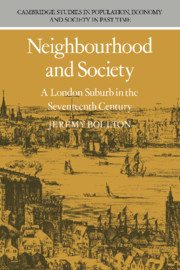Book contents
- Frontmatter
- Contents
- List of figures
- List of tables
- Preface
- Abbreviations
- 1 Introduction
- 2 The demographic background
- 3 Earning a living in early seventeenth-century Southwark
- 4 Wealth and social structure
- 5 Household structure and the household economy
- 6 Power, status and social mobility
- 7 Residential patterns and property ownership
- 8 The dynamics of a local community
- 9 Social relationships in the urban neighbourhood
- 10 The institutional structure of the neighbourhood
- 11 Conclusion: neighbourhood and society in seventeenth-century London
- Bibliography
- Index
6 - Power, status and social mobility
Published online by Cambridge University Press: 19 October 2009
- Frontmatter
- Contents
- List of figures
- List of tables
- Preface
- Abbreviations
- 1 Introduction
- 2 The demographic background
- 3 Earning a living in early seventeenth-century Southwark
- 4 Wealth and social structure
- 5 Household structure and the household economy
- 6 Power, status and social mobility
- 7 Residential patterns and property ownership
- 8 The dynamics of a local community
- 9 Social relationships in the urban neighbourhood
- 10 The institutional structure of the neighbourhood
- 11 Conclusion: neighbourhood and society in seventeenth-century London
- Bibliography
- Index
Summary
Power and influence in the urban neighbourhood
As we have seen, the primary position of social power derived from an individual's position as head of household. This power, however, was restricted by the size of each unit. Opportunities to influence the lives and behaviour of others were much wider in a society where wealth was divided unequally. ‘Formal’ or ‘institutional’ power derived from membership of local administrative bodies is the one usually emphasised by social historians. Possession of office of this sort gave individuals further influence over the social, economic and religious behaviour of their fellows. Before discussing the institutional aspects of individual power we should consider the informal opportunities to influence the lives of neighbours which derived from the unequal distribution of wealth discussed earlier. Unlike institutional power, however, evidence for the deployment of informal power is far less easy to come by. In a society where wealth was distributed unequally and where two thirds of all households had little money to spare, it is clear that those households which were able to do so might use surplus income as a means to power and influence. The ways in which money might be used in return for deference is a neglected form of informal social control in pre-industrial England.
One of the obvious means of converting wealth into a form of social capital was to provide dinners for neighbours.
- Type
- Chapter
- Information
- Publisher: Cambridge University PressPrint publication year: 1987
- 1
- Cited by

